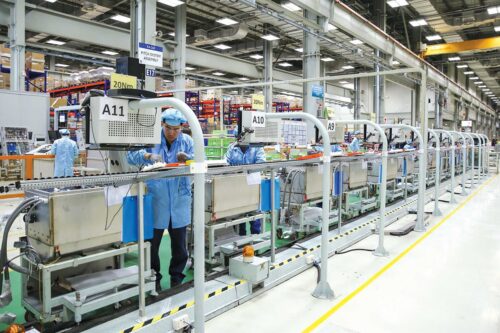The article by Mr. Dinh Hong Ky was published in the “Viewpoint” section of the online newspaper VnExpress.net on December 7, 2018.
The leader of a large Chinese tile and cladding materials manufacturing group came to Ho Chi Minh City to meet me in the middle of the year. They proposed a partnership to relocate their factories from Foshan, China, to Vietnam. The products would be manufactured in Vietnam and then exported to the United States in order to avoid the tariff barriers that President Trump had imposed—and might continue to impose—on Chinese goods.
The article by Mr. Đinh Hồng Kỳ was published in the “Viewpoint” section of the online newspaper VnExpress.net on December 7, 2018.
The leader of a major Chinese manufacturer of tile and cladding materials came to Ho Chi Minh City to meet me in the middle of the year. They proposed a partnership to relocate their factories from Foshan to Vietnam. The products would be manufactured in Vietnam and exported to the U.S. to bypass the tariff barriers imposed—and possibly extended—by President Trump on Chinese goods.
However, after just half a day of analyzing and comparing the projected Trump tariffs against the costs they would incur if they relocated to Vietnam, the company’s representative changed their mind. They concluded that although the U.S. import tariff might rise by only 10–15%, relocating their factory to Vietnam would increase their costs by 25–30%. The reasons: land rental prices in Ho Chi Minh City and nearby provinces are significantly higher than in Foshan; labor productivity in Vietnam is lower (even though wages are cheaper, the output doesn’t match); and raw material supply as well as particularly high domestic logistics costs are major challenges.
That’s not even counting the advantage of scale. If they were to move to Vietnam, they’d have to invest in production lines one by one, leading to a substantial cost spike—whereas currently, they are operating nine synchronized lines, saving significant resources. The next day, the company’s leadership returned to China, deciding not to invest in Vietnam but instead to focus on upgrading their systems at home.
That’s why I’m not fully convinced by the enthusiastic view that many Chinese companies will shift investment to Vietnam just to “avoid origin” rules in the ongoing U.S.-China trade war.
But the story doesn’t end there. I returned to China last month to visit construction materials manufacturers in Guangdong—and I was amazed by what I saw. The latest technologies are being swiftly adopted not just in daily life but also across business operations, with strong support from the Chinese government and enterprises. In tile manufacturing factories in Foshan, the application of robots and artificial intelligence (AI) is no longer rare. Just a few years ago, these places were filled with workers laboring in clouds of dust.
Changes in technology, environmental practices, and intellectual property compliance are becoming the new normal in China. The “heat” of transformation among Chinese businesses—driven by international pressure, including from the U.S.—is undeniable, as Western countries push China to play fair by enforcing technical standards.
I came to a realization: many Chinese enterprises are rapidly phasing out outdated technologies as a direct response to the Trump-Xi trade war. Upgrading and eliminating old technologies is nothing new to manufacturing industries, and China has been doing it for years. But now, facing the stark choice between transformation or shutdown, they’re launching a widespread reform wave. The elimination of obsolete technology is happening more aggressively than ever in the world’s factory.
As I stepped out of one such factory, a question struck me: now that China has entered the global playing field, where are all those outdated technologies and low-quality products—still widely used just two or three years ago—being redirected? I couldn’t help but connect this to a trend I’ve observed: over the past two years, industrial land rental prices in Ho Chi Minh City and nearby provinces like Binh Duong, Dong Nai, Long An, and Ba Ria – Vung Tau have skyrocketed. A notable portion of this demand comes from mainland Chinese businesses, willing to pay top dollar for prime industrial locations. Naturally, they bring along their machinery, equipment, and even personnel.
The owner of a major construction materials company in Guangdong recently told me that Vietnam is currently China’s second-largest export market for building materials—just after the U.S. I was genuinely surprised that such a relatively small market like Vietnam could account for such a significant share of China’s exports in this sector.
This led me to another question: Are we witnessing a repeat of the phenomenon from nearly 20 years ago, when cheap Chinese motorbikes and assembly lines flooded Vietnam’s market after China began banning domestic motorbike use?
How many of us have truly grasped the full picture? Last week, I attended a seminar in Ho Chi Minh City on the topic of the “Trade War.” At this event, experts analyzed the opportunities and challenges for Vietnam’s economy and businesses amid the tense U.S.-China trade conflict. Many seemed excited about the prospect of foreign investment shifting away from China to other countries, including Vietnam; the opportunities for Vietnamese enterprises as the U.S. forces China to play by new rules; or the challenges posed by Chinese investments and products flooding Vietnam to change origin and re-export to the U.S. to avoid tariffs.
Reflecting on my own experiences, I wonder: is that really all there is to the “opportunities and challenges” for Vietnam? For me, the trade war is already impacting Vietnam—but in ways different from what we are speculating about among ourselves. And yet, I have not seen any government agency provide information, let alone offer warnings about potential consequences for businesses or the general public.
As an entrepreneur, I hope the government and policymakers will understand the deeper, hidden parts of the iceberg—sharing more information with businesses, even offering warnings about possible developments in this “war” to prevent Vietnam from becoming the “backyard” of any major power.
Dinh Hong Ky


